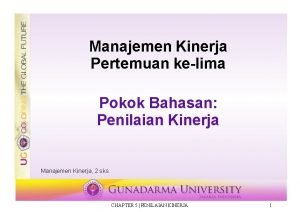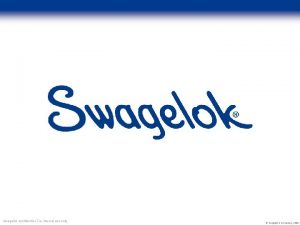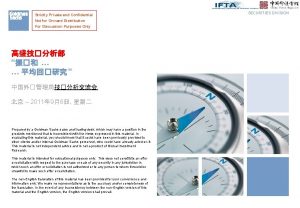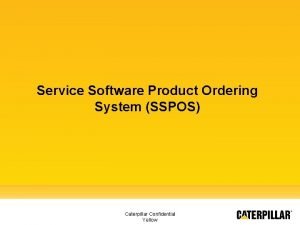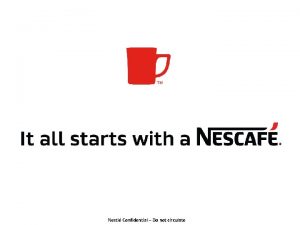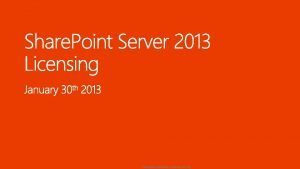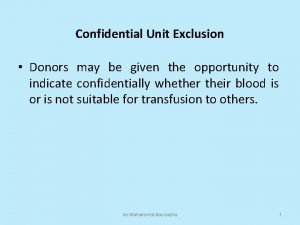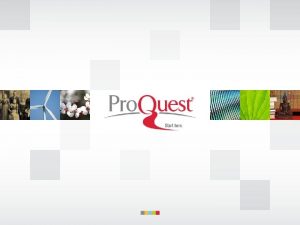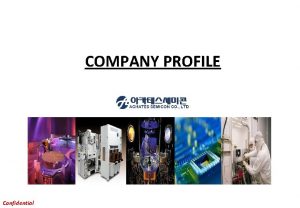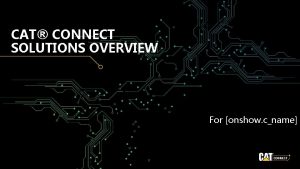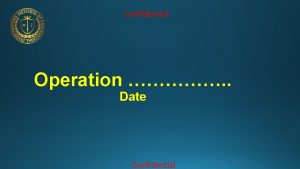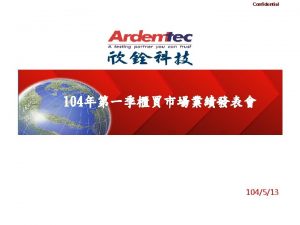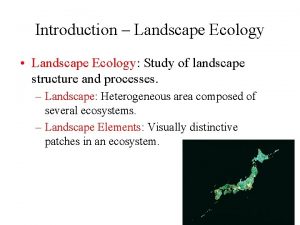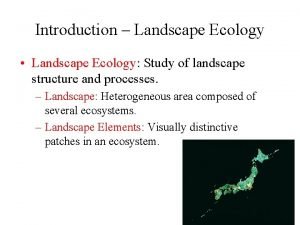CONFIDENTIAL Performance management landscape Multipractice performance management meeting




















- Slides: 20

CONFIDENTIAL Performance management landscape Multi-practice performance management meeting Discussion document April 6 -7, 1998 ZXW 004 Apr 6 -7/98 -TO JHbm 97

WHY WE ARE HERE Today’s objectives Situation re performance management • Client interest in topic • Lots of confusion about it • Mc. Kinsey knowledge deep, but dispersed • Criitical to capturing value from our engagements 1 ZXW 004 Apr 6 -7/98 -TO JHbm 97

DISCUSSION TOPICS • Scope definition • Performance management landscape • Effective business performance management 2

SCOPE DEFINITION PERFORMANCE BUZZWORD CONFUSION fficer ance o m f perfor Chie provement Value-b ased m anagem ent ives cent + in tion ensa ce forman Benchmarking p Com Continuous im Performance enhancement processe s Total Change management Per ation ing organiz rm o rf e p h ig H ing ep t-lin erf a orm ation Dis tinc Consequences tive Sharpbenders perfo High rces fo work nce Key perfo rmance indicator s nce evalu g rmin ds ecar r o c s cad Cas Performa ent urem s a e em nc forma nal per operatio High performing teams per form anc ee thic Corporate govern ance Balanc ed sco recard n Fro 3

FOCUS ON PERFORMANCE IMPROVEMENT Performance improvement related Qualities of high performing companies • Capabilities • Strategic insights • Culture • Operational excellence • Competitive advantages • Good governance Steps companies can take to improve performance • Performance culture management • Episodic business change programs • Performance • Ongoing performance practices • Etc. Examples of major Mc. Kinsey knowledge efforts • High performing organizations • Corporate governance • War for talent • Several functional and sector-specific efforts • Etc. • Ongoing performance ethic • High performing workforces • Sharpbenders management – Value-based management – HR best practices – Continuous improvement • Change initiatives – Change centre – Performance enhancement processes (e. g. , AVA, CPR) – Etc. 4

SPECIFIC FOCUS ON ONGOING PERFORMANCE MANAGEMENT Specific focus Examples Through episodic business change programs • Restructuring • Strategic redefinition • Process redesign • Capability building • Traditional retail concept renewal • PEPs (e. g. , AVA, CPR) Performance improvement Through changing performance context Through managing ongoing performance • Performance ethic • Employee value proposition • Measuring performance • Setting targets • Evaluating people • Executing and monitoring improvement action plans • Business planning Linkage to performance management • Can apply the principles of performance management to help – Consistently identify the need for change over time – Ensure a successful transition and capture of benefits in a change program • Sets the stage for effective performance management • Is the core focus of performance management 5

DISCUSSION TOPICS • Scope definition • Performance management landscape • Effective business performance management 6

PERFORMANCE MANAGEMENT LANDSCAPE THREE PRIMARY TYPES OF PERFORMANCE MANAGEMENT LEVERS Performance ethic (contextual) The context, organizational culture, and mindsets that set the stage for performance Total Performance performance Management management Business performance management (systematic) HR performance management (human) The methodologies and processes that measure and manage the performance of a business The processes and incentives that maximize human resources performance 7

KEY ELEMENTS OF PERFORMANCE ETHIC Performance ethic Total Performance Management Deliberate, consistent use of control and motivational levers • Distinctive practices on 2 -3 Clarity of direction • Clear strategy, aspirations, and priorities Clarity of accountability • Minimize structural complexity • Appropriate empowerment Effective performance management systems Business performance management control and motivational levels – People – Financial control/planning – Operational control/planning – Incentives – Opportunities – Values HR performance management • Business performance management • HR performance management 8

KEY ELEMENTS OF BUSINESS PERFORMANCE MANAGEMENT Performance ethic Measurement and reporting • Performance drivers and Opportunity identification and capture • Benchmarking • Targets • Action plans Managing process and dialog • Regular reviews • Discussion of root causes and • measures Regular transparent reporting remedies • Recognition Business performance management Total Performance Management HR performance management 9

KEY ELEMENTS OF HR PERFORMANCE MANAGEMENT Performance ethic Assessment • Objective setting • Performance evaluation Managing process and dialog • Regular reviews • Ongoing feedback and Consequences • Recognition and • Total Performance Management Business performance management coaching • • celebration Compensation and incentives Career progression/ retrenchment Remedial action plans HR performance management 10

PERFORMANCE MANAGEMENT LANDSCAPE Performance management lever Performance ethic Organization level Aspiration, direction, & priorities Accountability Business performance management 6 levers Opportunity Measurement + ID and capture reporting Managing process/ dialogue HR performance management Assessment Managing process/ dialogue Consequences Corporate/ CEO Business unit Key so what’s • Performance management approaches should be tailored to different levels Process, function, or geography • Various methodologies apply to different parts of the landscape • Tight integration between levers and levels is critical Sub-process, department, or location Team, individual, or machine 11

APPLICABILITY OF DIFFERENT PERFORMANCE MANAGEMENT TECHNIQUES Performance management lever Performance ethic Organization level Aspiration, direction, & priorities Accountability Business performance management 6 levers Opportunity Managing process/ Measurement ID and capture dialog + reporting HR performance management Assessment Managing process/ dialog Consequences Corporate/ CEO Business unit EVA, balanced scorecard Value-based management KPI Continuous improvement Managing leadership talent for performance + HR best practices Performance ethic Process, function, or geography Sub-process, department, or location Team, individual, or machine HR best practices Front-line improvement High performing workforces 12

INTEGRATING ORGANIZATIONAL LEVELS FOR DISCUSSION • Every level’s performance drivers is connected to an overriding and corporate objective (or set of objectives) • A significant portion of each level’s performance is driven by the performance of lower levels • A level should only be held accountable for performance drivers it can control • Others? 13

DISCUSSION TOPICS • Scope definition • Performance management landscape • Effective business performance management 14

EFFECTIVE BUSINESS PERFORMANCE MANAGEMENT: CORE REQUIREMENTS Region $ Local unit Individual # $ $ # Performance measurement and reporting • Cascading linkage to overriding • • • ? # organizational objectives Balance of results-focused and future growth-focused drivers Measuring results given opportunities Prioritized key performance drivers Regular transparent reporting Continuous renewal of performance focus Opportunity capture • Best opportunity fact • • base possible Setting stretch targets Crafting and executing action plans Managing process and dialog • Regular cycle of reviews • Brainstorming on root causes and remedies • Sharing of best practices • Recognition and celebration 15

THE ALTERNATIVE BALANCED SCORECARD? Sustained shareholder value creation Horizon 3 Horizon 2 Horizon 1 Shorter-term results Medium-term growth Long-term growth Primary success factor • Superior execution • Positional advantage • Insight/foresight Measurement emphasis • Bottom-line results • Top-line growth • Option value Examples of performance drivers • Growth in NI • ROIC • Productivity • Rate and quality of • Option value • Number of promising and cash flow improvement Type of measure • Mostly quantitative results • • innovation New customer acquisition Customer satisfaction Brand loyalty Employee capabilities • Leading indicators – both quantitative and qualitative initiatives • Leading indicators – both quantitative and qualitative 16

ILLUSTRATIVE NEED FOR PERFORMANCE FOCUS RENEWAL Past Branch-based banking 1990 s Branch-based relationship but multiple CAPS Future FI relationship with multiple CAPS Convenience banking measures • Fee revenue • Teller utilization • Diversion ratio • Fee revenue • Diversion rate • ABM profitability • Video kiosk profitability Relationship management measures • Funds managed • Number of CIFs • Product penetration • Customer retention • Sales ($)/FTE • Number of customer portfolios • Funds managed growth • Share of wallet • Customer retention • Relationship profitability 17

BUSINESS PERFORMANCE MANAGEMENT – TIPS FOR EFFECTIVENESS Region $ Local unit Individual # $ $ ? # # Performance measurement and reporting Opportunity capture Managing process and dialog • Prioritized set of top level drivers • Benchmarks – use both • Structured calendar of • • – “the closely watched numbers” More detailed set of drivers for effective diagnosis Consistent with strategy Tailored to organizational operating environment and authority levels Balanced drivers to avoid overemphasis (e. g. , price vs. volume) • • internal and external where possible Mix of bottom-up and top -down targets Document and monitor action steps and milestones • multilevel review and coaching meetings Linked in with major business processes to become an integral part of day-to-day activity 18

TAILORING LEVERS TO DIFFERENT ORGANIZATIONAL LEVELS FOR DISCUSSION Performance management lever Performance ethic Organization level Corporate/ CEO Aspiration, direction, & priorities Accountability Business performance management 6 levers • Performance ethic driven by company’s/CEO’s key control and motivational levers Opportunity Managing process/ Measurement ID and capture dialog + reporting • Key performance drivers • Business unit more directly linked to shareholder value and financial success Target timeframes more likely to be annual or multiyear HR performance management Assessment Managing process/ dialog Consequences • Compensation is primary incentive tool • Compensation structure more individualized Process, function, or geography Sub-process, department, or location • Performance ethic driven by • Key performance drivers more employee value proposition Team, individual, or machine • activity- and process-based drivers and more narrowly focused Target timeframes more likely to be hourly, daily, monthly, quarterly or less than 1 year • More reliance on nonfinancial incentives • More standardized compensation programs Back-up 19
 For today's meeting
For today's meeting Today meeting or today's meeting
Today meeting or today's meeting What is meeting and types of meeting
What is meeting and types of meeting Types of meeting
Types of meeting Behaviorally anchored rating scale
Behaviorally anchored rating scale Performance levels
Performance levels Segmentation targeting differentiation and positioning
Segmentation targeting differentiation and positioning Meeting performance
Meeting performance Confidential internal use only
Confidential internal use only Confidential not to be distributed
Confidential not to be distributed Caterpillar confidential green yellow red
Caterpillar confidential green yellow red Confidential do not circulate
Confidential do not circulate Confidential internal use only
Confidential internal use only Caterpillar: confidential green
Caterpillar: confidential green Company confidential profile
Company confidential profile Hostway_site_control
Hostway_site_control Confidential all rights reserved
Confidential all rights reserved Confidential unit exclusion
Confidential unit exclusion Confidential not for distribution
Confidential not for distribution Confidential company profile
Confidential company profile Cat connect
Cat connect







